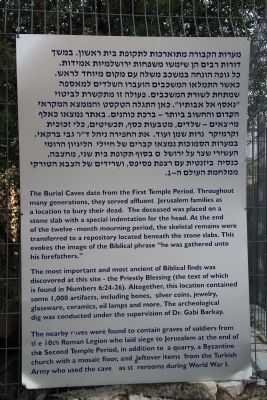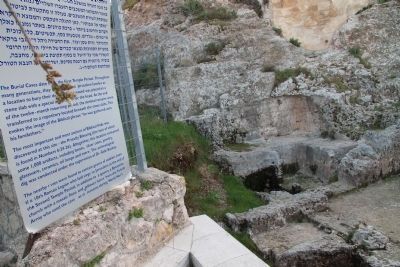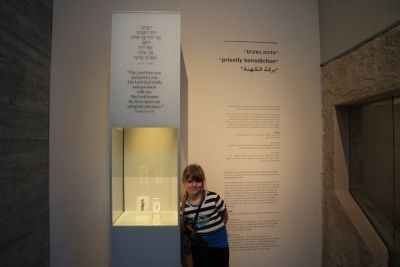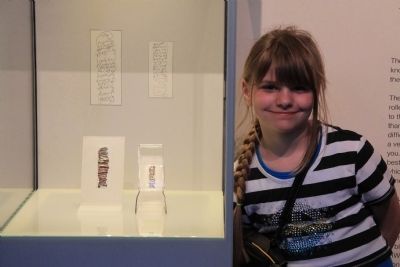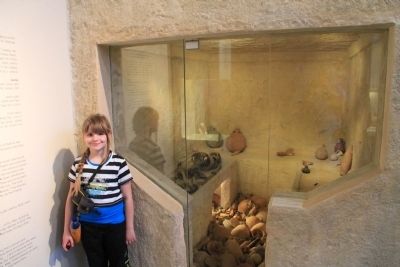Jerusalem, Jerusalem District, Israel — The Middle East (West Asia)
Ketef Hinnom
The most important and most ancient of Biblical finds was discovered at this site - the Priestly Blessing (the text of which is found in Numbers 6:24-26). Altogether, this location contained some 1,000 artifacts, including bones, silver coins, jewelry, glassware, ceramics, oil lamps and more. The archeological dig was conducted under the supervision of Dr. Gabi Barkay.
The nearby caves were found to contain graves of soldiers from the 10th Roman Legion who laid siege to Jerusalem at the end of the Second Temple Period, in addition to a quarry, a Byzantine church with a mosaic floor, and leftover items from the Turkish Army who used the caves as storerooms during World War I.
Topics. This historical marker is listed in these topic lists: Cemeteries & Burial Sites • Man-Made Features.
Location. 31° 46.141′ N, 35° 13.537′ E. Marker is in Jerusalem, Jerusalem District. Marker can be reached from S.U. Nahon Street just east of David HaMelech, on the right when traveling east. Both this historical marker, and the rock cut burial tombs that are featured on this historical marker, are located on a narrow strip of fenced off land that is located between the Menahem Begin Center to the east and the St. Andrews Church of Scotland to the west. In order to actually get to this historical marker legally you must go through the Menahem Begin Center. Touch for map. Marker is at or near this postal address: 6 SU Nahon Street, Jerusalem, Jerusalem District 94110, Israel. Touch for directions.
Other nearby markers. At least 8 other markers are within walking distance of this marker. Cave 24 (here, next to this marker); The Priestly Blessing (a few steps from this marker); Tombs from the First Temple Period (within shouting distance of this marker); The Temple Society People's House (approx. 0.3 kilometers away); The Mount Zion Trench (approx. 0.3 kilometers away); Mishkenot Sheananim (approx. 0.3 kilometers away); Jerusalem Walls National Park (approx. 0.4 kilometers away in Israel); King David's Tomb (approx. half a kilometer away in Israel). Touch for a list and map of all markers in Jerusalem.
More about this marker. With regards to what this marker refers to as, "The most important and most ancient of Biblical finds was discovered at this site - the Priestly
Blessing." I have the good fortune of knowing the archaeologist who made this discovery, back in 1979, Dr. Judith Hadley of Villanova University. As I was preparing to come to Israel, I contacted Dr. Hadley and asked her a number of questions about some of the sites that were to be found in Israel, but in particular I wanted her insights on how to reach the site at Ketef Hinnom, where she had made her important discovery as part of Dr. Gabi Barkay's excavation team. Her insights on how to get to this historical marker, and on what I would find at this marker's location, were indispensable to the success of my locating and photographing both this historical marker and the rock cut tombs that the marker's text refers to. Here is what she has to say:
"Now, as to the site of the tombs themselves, you are right that they are right there at St. Andrew's Church of Scotland. The church was built on the limestone escarpment where the tombs are located, so the tombs are all there right below the (outside of the) church - as we were digging we would have been able to walk over to where the apse of the church was built and touch its foundations. As of 2 years ago, the last time I was there, it was still possible to see the tombs there along the escarpment. But it is now a lot trickier. The Israelis have built the "Menahem Begin Center" right on top of the ridge there below the church,
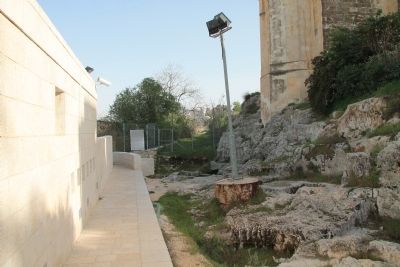
Photographed By Dale K. Benington, March 13, 2013
3. Ketef Hinnom Marker
A distant view of the historical marker, attached to the chain link fence at the end of the walkway, with the Menachem Begin Heritage Center on the left side of the picture, the base of St. Andrews Church of Scotland on the right side of the picture, and the featured, First Temple Period, rock cut tombs, in the space in between.
Regarding Ketef Hinnom. It should be noted that the artifacts recovered at this
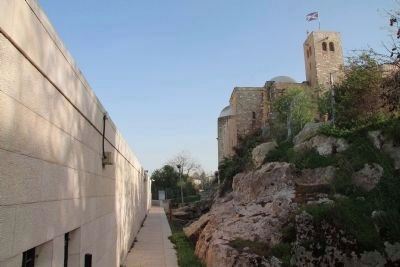
Photographed By Dale K. Benington, March 13, 2013
4. Ketef Hinnom Marker
A more distant view of the historical marker, attached to the chain link fence at the end of the walkway, with the Menachem Begin Heritage Center on the left side of the picture, the base of St. Andrews Church of Scotland (I used the tower of the church, with the Scottish flag as a landmark) on the right side of the picture, and the featured, First Temple Period, rock cut tombs, in the space in between.
So because of this, when I visited the Israel Museum, I made a point of finding the display that showcased the silver scroll amulets, and put my youngest daughter beside the display, and took a picture.
In addition to having a display for the silver scroll amulets, right beside this display, the Israel Museum has a second display that is a reproduction of the First Temple Period, rock cut tomb, where the silver scroll amulets were found.
Also see . . .
1. 'Silver scrolls' are oldest O.T. scripture. This is a link to information provided by the Baptist Press. (Submitted on March 24, 2013, by Dale K. Benington of Toledo, Ohio.)
2. Silver Scrolls. This is a link to information provided by the Crystalinks. (Submitted on March 24, 2013, by Dale K. Benington of Toledo, Ohio.)
3. Miniature Writing on Ancient Amulets. This is a link to information provided by the Biblical Archaeology Society. (Submitted on March 24, 2013, by Dale K. Benington of Toledo, Ohio.)
4. Ketef Hinnom. This is a link to information provided
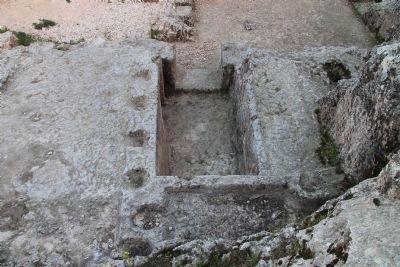
Photographed By Dale K. Benington, March 13, 2013
5. Ketef Hinnom Rock Cut Tomb
An overhead view of the featured, First Temple Period, rock cut burial tomb, where the grave goods where discovered. According to the text of the historical marker, "The most important and most ancient of Biblical finds was discovered at this site - the Priestly Blessing."
5. The Ketef Hinnom Archaeological Site in Jerusalem. This is a link to a link to a You Tube posting provided by AllAboutJerusalem. (Submitted on March 25, 2013, by Dale K. Benington of Toledo, Ohio.)
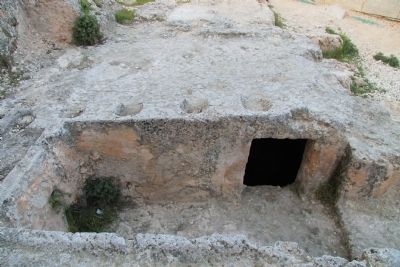
Photographed By Dale K. Benington, March 13, 2013
6. Ketef Hinnom Rock Cut Tomb
Another view of the featured, First Temple Period, rock cut tomb, showing that underneath the bench with all the headrests is a chamber hollowed out of the rock. It was in this chamber that the silver amulet, with the priestly blessing, was found.
Credits. This page was last revised on October 25, 2019. It was originally submitted on March 24, 2013, by Dale K. Benington of Toledo, Ohio. This page has been viewed 1,583 times since then and 45 times this year. Photos: 1, 2, 3, 4, 5, 6, 7, 8, 9. submitted on March 24, 2013, by Dale K. Benington of Toledo, Ohio.
